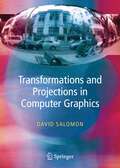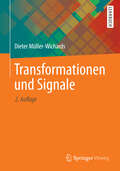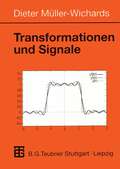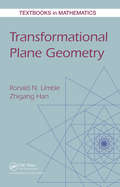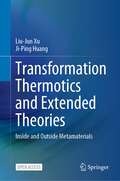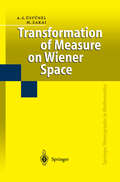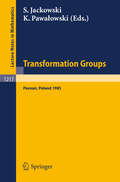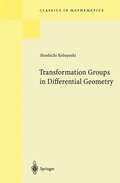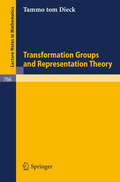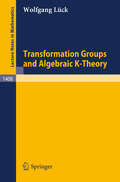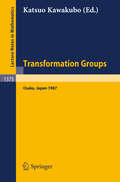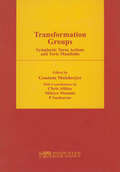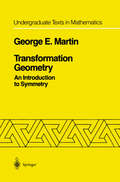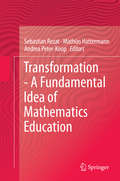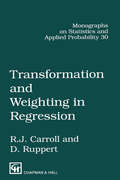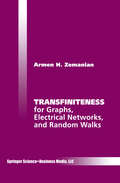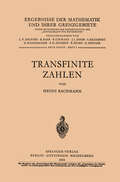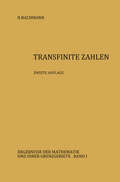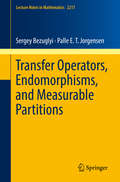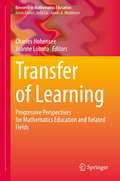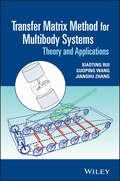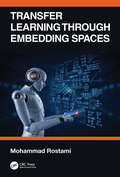- Table View
- List View
Transformations and Projections in Computer Graphics
by David SalomonThis book introduces perspective, and discusses the mathematics of perspective in a detailed, yet accessible style. It also reviews nonlinear projections, including the fisheye, panorama, and map projections frequently used to enhance digital images. Topics and features include a complete and self-contained presentation of concepts, principles, and methods; a 12-page colour section, and numerous figures. This essential resource for computer professionals both within and outside the field of Computer Graphics is also suitable for graduates and advanced undergraduates in Computer Graphics and Computer-Aided Design. Key ideas are introduced, examined and illustrated by figures and examples, and reinforced through solved exercises.
Transformationen und Signale
by Dieter Müller-WichardsDie Behandlung kontinuierlicher und diskreter Signale und die Beschreibung entsprechender zeitunabhängiger linearer Systeme in Regelungs-, Nachrichten- und Digitaltechnik erfordert eine Reihe von Transformationen, die in dem vorliegenden Text bereitgestellt werden. Besonderer Wert wird auf die Darlegung der für die Anwendung wichtigen Zusammenhänge zwischen verschiedenen Transformationen gelegt. Dieses Buch ist als Begleittext einer einschlägigen Vorlesung für Studierende der Elektrotechnik, Technischen Informatik oder Technomathematik gedacht.
Transformationen und Signale
by Dieter Müller-WichardsDie Behandlung kontinuierlicher und diskreter Signale und die Beschreibung entsprechender zeitunabhängiger linearer Systeme in Regelungs-, Nachrichten- und Digitaltechnik erfordert eine Reihe von Transformationen, die in dem vorliegenden Text bereitgestellt werden. Besonderer Wert wird auf die Darlegung der für die Anwendung wichtigen Zusammenhänge zwischen verschiedenen Transformationen gelegt. Dieses Buch ist als Begleittext einer einschlägigen Vorlesung für Studenten der Elektrotechnik, Technischen Informatik oder Technomathematik gedacht.
Transformational Plane Geometry (Textbooks In Mathematics Ser.)
by Ronald N. UmbleDesigned for a one-semester course at the junior undergraduate level, Transformational Plane Geometry takes a hands-on, interactive approach to teaching plane geometry. The book is self-contained, defining basic concepts from linear and abstract algebra gradually as needed.The text adheres to the National Council of Teachers of Mathematics Principl
Transformation Thermotics and Extended Theories: Inside and Outside Metamaterials
by Liu-Jun Xu Ji-Ping HuangThis open access book describes the theory of transformation thermotics and its extended theories for the active control of macroscopic thermal phenomena of artificial systems, which is in sharp contrast to classical thermodynamics comprising the four thermodynamic laws for the passive description of macroscopic thermal phenomena of natural systems. This monograph consists of two parts, i.e., inside and outside metamaterials, and covers the basic concepts and mathematical methods, which are necessary to understand the thermal problems extensively investigated in physics, but also in other disciplines of engineering and materials. The analyses rely on models solved by analytical techniques accompanied by computer simulations and laboratory experiments. This monograph can not only be a bridge linking three first-class disciplines, i.e., physics, thermophysics, and materials science, but also contribute to interdisciplinary development.
Transformation of Measure on Wiener Space (Springer Monographs in Mathematics)
by A.Süleyman Üstünel Moshe ZakaiThis unique book on the subject addresses fundamental problems and will be the standard reference for a long time to come. The authors have different scientific origins and combine these successfully, creating a text aimed at graduate students and researchers that can be used for courses and seminars.
Transformation Groups Poznan 1985: Proceedings of a Symposium held at Poznan, July 5-9, 1985 (Lecture Notes in Mathematics #1217)
by Stefan Jackowski Krzysztof PawalowskiTransformation Groups in Differential Geometry (Classics in Mathematics)
by Shoshichi KobayashiGiven a mathematical structure, one of the basic associated mathematical objects is its automorphism group. The object of this book is to give a biased account of automorphism groups of differential geometric struc tures. All geometric structures are not created equal; some are creations of ~ods while others are products of lesser human minds. Amongst the former, Riemannian and complex structures stand out for their beauty and wealth. A major portion of this book is therefore devoted to these two structures. Chapter I describes a general theory of automorphisms of geometric structures with emphasis on the question of when the automorphism group can be given a Lie group structure. Basic theorems in this regard are presented in §§ 3, 4 and 5. The concept of G-structure or that of pseudo-group structure enables us to treat most of the interesting geo metric structures in a unified manner. In § 8, we sketch the relationship between the two concepts. Chapter I is so arranged that the reader who is primarily interested in Riemannian, complex, conformal and projective structures can skip §§ 5, 6, 7 and 8. This chapter is partly based on lec tures I gave in Tokyo and Berkeley in 1965.
Transformation Groups and Algebraic K-Theory (Lecture Notes in Mathematics #1408)
by Wolfgang LückThe book focuses on the relation between transformation groups and algebraic K-theory. The general pattern is to assign to a geometric problem an invariant in an algebraic K-group which determines the problem. The algebraic K-theory of modules over a category is studied extensively and appplied to the fundamental category of G-space. Basic details of the theory of transformation groups sometimes hard to find in the literature, are collected here (Chapter I) for the benefit of graduate students. Chapters II and III contain advanced new material of interest to researchers working in transformation groups, algebraic K-theory or related fields.
Transformation Groups: Proceedings of a Conference, held in Osaka, Japan, Dec. 16-21, 1987 (Lecture Notes in Mathematics #1375)
by Katsuo KawakuboTransformation Geometry: An Introduction to Symmetry (Undergraduate Texts in Mathematics)
by George E. MartinTransformation Geometry: An Introduction to Symmetry offers a modern approach to Euclidean Geometry. This study of the automorphism groups of the plane and space gives the classical concrete examples that serve as a meaningful preparation for the standard undergraduate course in abstract algebra. The detailed development of the isometries of the plane is based on only the most elementary geometry and is appropriate for graduate courses for secondary teachers.
Transformation - A Fundamental Idea of Mathematics Education: A Fundamental Idea Of Mathematics Education
by Sebastian Rezat Mathias Hattermann Andrea Peter-KoopThe diversity of research domains and theories in the field of mathematics education has been a permanent subject of discussions from the origins of the discipline up to the present. On the one hand the diversity is regarded as a resource for rich scientific development on the other hand it gives rise to the often repeated criticism of the discipline’s lack of focus and identity. As one way of focusing on core issues of the discipline the book seeks to open up a discussion about fundamental ideas in the field of mathematics education that permeate different research domains and perspectives. The book addresses transformation as one fundamental idea in mathematics education and examines it from different perspectives. Transformations are related to knowledge, related to signs and representations of mathematics, related to concepts and ideas, and related to instruments for the learning of mathematics. The book seeks to answer the following questions: What do we know about transformations in the different domains? What kinds of transformations are crucial? How is transformation in each case conceptualized?
Transformation - Enlargement of a Triangle (tactile)
by RnibThis diagram shows how a triangle can be transformed over a grid to be enlarged.
Transformation and Weighting in Regression
by David Ruppert Raymond J. CarrollThis monograph provides a careful review of the major statistical techniques used to analyze regression data with nonconstant variability and skewness. The authors have developed statistical techniques--such as formal fitting methods and less formal graphical techniques-- that can be applied to many problems across a range of disciplines, including pharmacokinetics, econometrics, biochemical assays, and fisheries research.While the main focus of the book in on data transformation and weighting, it also draws upon ideas from diverse fields such as influence diagnostics, robustness, bootstrapping, nonparametric data smoothing, quasi-likelihood methods, errors-in-variables, and random coefficients. The authors discuss the computation of estimates and give numerous examples using real data. The book also includes an extensive treatment of estimating variance functions in regression.
Transformation and Weighting in Regression
by David Ruppert Raymond J. CarrollThis monograph provides a careful review of the major statistical techniques used to analyze regression data with nonconstant variability and skewness. The authors have developed statistical techniques--such as formal fitting methods and less formal graphical techniques-- that can be applied to many problems across a range of disciplines, including pharmacokinetics, econometrics, biochemical assays, and fisheries research.While the main focus of the book in on data transformation and weighting, it also draws upon ideas from diverse fields such as influence diagnostics, robustness, bootstrapping, nonparametric data smoothing, quasi-likelihood methods, errors-in-variables, and random coefficients. The authors discuss the computation of estimates and give numerous examples using real data. The book also includes an extensive treatment of estimating variance functions in regression.
Transfiniteness: For Graphs, Electrical Networks, and Random Walks
by Armen H. Zemanian"What good is a newborn baby?" Michael Faraday's reputed response when asked, "What good is magnetic induction?" But, it must be admitted that a newborn baby may die in infancy. What about this one- the idea of transfiniteness for graphs, electrical networks, and random walks? At least its bloodline is robust. Those subjects, along with Cantor's transfinite numbers, comprise its ancestry. There seems to be general agreement that the theory of graphs was born when Leonhard Euler published his solution to the "Konigsberg bridge prob lem" in 1736 [8]. Similarly, the year of birth for electrical network theory might well be taken to be 184 7, when Gustav Kirchhoff published his volt age and current laws [ 14]. Ever since those dates until just a few years ago, all infinite undirected graphs and networks had an inviolate property: Two branches either were connected through a finite path or were not connected at all. The idea of two branches being connected only through transfinite paths, that is, only through paths having infinitely many branches was never invoked, or so it appears from a perusal of various surveys of infinite graphs [17], [20], [29], [32]. Our objective herein is to explore this idea and some of its ramifications. It should be noted however that directed graphs having transfinite paths have appeared in set theory [6, Section 4.
Transfinite Zahlen (Ergebnisse der Mathematik und ihrer Grenzgebiete. 2. Folge #1)
by Heinz BachmannDer vorliegende Bericht soll dem Leser die Ergebnisse und Probleme der Theorie der transfiniten Zahlen (Ordnungszahlen und Mächtigkeiten) nach ihrem heutigen Stande vermitteln, wobei die arithmetischen Fragen ziemlich erschöpfend erörtert werden, während auf axiomatische Fra gen weniger stark eingegangen wird. Die Grundlage bildet dabei das ZERMELO-FRAENKELsche Axiomensystem der Mengenlehre; die Anwen dung des Auswahlaxioms wird stets hervorgehoben. Um die Beschränkung auf einen bestimmten Formalismus zu vermeiden und zwecks besserer Lesbarkeit ist alles in der Sprache der naiven Mengenlehre formuliert. Nach einer allgemeinen Einleitung findet der Leser eine Darstellung der Theorie der Ordnungszahlen, wobei das Auswahlaxiom nur in Aus nahmefällen verwendet wird. Die neuen Ergebnisse über Normalfunktionen (§§7, 16) und über regressive Funktionen (§ 9) sowie die einfache Dar stellung der Theorie der Hauptzahlen (§§ 15,16) dürften dabei besonders von Interesse sein. Sodann folgt die Theorie der Mächtigkeiten; zuerst wird gezeigt, welche ersten Schritte in dieser Theorie ohne Auswahlaxiom ausgeführt werden können; dann wird die Theorie unter Verwendung des Auswahlaxioms (und ausführlicher) weiter entwickelt. Den Äquivalenzen zum Auswahlaxiom (§ 31) und zur Alephhypothese (§ 35) sowie den un erreichbaren Zahlen (§§ 40-42) wird besondere Beachtung geschenkt. Auf das Problem der formalen Darstellung von Ordnungszahlen, auf Anwen dungen der transfiniten Zahlen in der Theorie der Punktmengen und andere Anwendungen konnte wegen des beschränkten zur Verfügung stehenden Raumes nicht stark eingegangen werden. Am Scllluß findet sich ein Literaturverzeichnis, in dem die modernen Arbeiten fast voll ständig, die älteren nur teilweise aufgeführt sind, sowie ein Sachver zeichnis.
Transfinite Zahlen (Ergebnisse der Mathematik und ihrer Grenzgebiete. 2. Folge #1)
by Heinz BachmannTransfer Operators, Endomorphisms, and Measurable Partitions (Lecture Notes in Mathematics #2217)
by Sergey Bezuglyi Palle E. JorgensenThe subject of this book stands at the crossroads of ergodic theory and measurable dynamics. With an emphasis on irreversible systems, the text presents a framework of multi-resolutions tailored for the study of endomorphisms, beginning with a systematic look at the latter. This entails a whole new set of tools, often quite different from those used for the “easier” and well-documented case of automorphisms. Among them is the construction of a family of positive operators (transfer operators), arising naturally as a dual picture to that of endomorphisms. The setting (close to one initiated by S. Karlin in the context of stochastic processes) is motivated by a number of recent applications, including wavelets, multi-resolution analyses, dissipative dynamical systems, and quantum theory. The automorphism-endomorphism relationship has parallels in operator theory, where the distinction is between unitary operators in Hilbert space and more general classes of operators such as contractions. There is also a non-commutative version: While the study of automorphisms of von Neumann algebras dates back to von Neumann, the systematic study of their endomorphisms is more recent; together with the results in the main text, the book includes a review of recent related research papers, some by the co-authors and their collaborators.
Transfer of Learning: Progressive Perspectives for Mathematics Education and Related Fields (Research in Mathematics Education)
by Charles Hohensee Joanne LobatoThis book provides a common language for and makes connections between transfer research in mathematics education and transfer research in related fields. It generates renewed excitement for and increased visibility of transfer research, by showcasing and aggregating leading-edge research from the transfer research community. This book also helps to establish transfer as a sub-field of research within mathematics education and extends and refines alternate perspectives on the transfer of learning. The book provides an overview of current knowledge in the field as well as informs future transfer research.
Transfer Matrix Method for Multibody Systems: Theory and Applications
by Xiaoting Rui Guoping Wang Jianshu ZhangTRANSFER MATRIX METHOD FOR MULTIBODY SYSTEMS: THEORY AND APPLICATIONS Xiaoting Rui, Guoping Wang and Jianshu Zhang - Nanjing University of Science and Technology, China Featuring a new method of multibody system dynamics, this book introduces the transfer matrix method systematically for the first time. First developed by the lead author and his research team, this method has found numerous engineering and technological applications. Readers are first introduced to fundamental concepts like the body dynamics equation, augmented operator and augmented eigenvector before going in depth into precision analysis and computations of eigenvalue problems as well as dynamic responses. The book also covers a combination of mixed methods and practical applications in multiple rocket launch systems, self-propelled artillery as well as launch dynamics of on-ship weaponry. • Comprehensively introduces a new method of analyzing multibody dynamics for engineers • Provides a logical development of the transfer matrix method as applied to the dynamics of multibody systems that consist of interconnected bodies • Features varied applications in weaponry, aeronautics, astronautics, vehicles and robotics Written by an internationally renowned author and research team with many years' experience in multibody systems Transfer Matrix Method of Multibody System and Its Applications is an advanced level text for researchers and engineers in mechanical system dynamics. It is a comprehensive reference for advanced students and researchers in the related fields of aerospace, vehicle, robotics and weaponry engineering.
Transfer Matrix Method for Multibody Systems: Theory and Applications
by Xiaoting Rui Guoping Wang Jianshu ZhangTRANSFER MATRIX METHOD FOR MULTIBODY SYSTEMS: THEORY AND APPLICATIONS Xiaoting Rui, Guoping Wang and Jianshu Zhang - Nanjing University of Science and Technology, China Featuring a new method of multibody system dynamics, this book introduces the transfer matrix method systematically for the first time. First developed by the lead author and his research team, this method has found numerous engineering and technological applications. Readers are first introduced to fundamental concepts like the body dynamics equation, augmented operator and augmented eigenvector before going in depth into precision analysis and computations of eigenvalue problems as well as dynamic responses. The book also covers a combination of mixed methods and practical applications in multiple rocket launch systems, self-propelled artillery as well as launch dynamics of on-ship weaponry. • Comprehensively introduces a new method of analyzing multibody dynamics for engineers • Provides a logical development of the transfer matrix method as applied to the dynamics of multibody systems that consist of interconnected bodies • Features varied applications in weaponry, aeronautics, astronautics, vehicles and robotics Written by an internationally renowned author and research team with many years' experience in multibody systems Transfer Matrix Method of Multibody System and Its Applications is an advanced level text for researchers and engineers in mechanical system dynamics. It is a comprehensive reference for advanced students and researchers in the related fields of aerospace, vehicle, robotics and weaponry engineering.
Transfer Learning through Embedding Spaces
by Mohammad RostamiRecent progress in artificial intelligence (AI) has revolutionized our everyday life. Many AI algorithms have reached human-level performance and AI agents are replacing humans in most professions. It is predicted that this trend will continue and 30% of work activities in 60% of current occupations will be automated. This success, however, is conditioned on availability of huge annotated datasets to training AI models. Data annotation is a time-consuming and expensive task which still is being performed by human workers. Learning efficiently from less data is a next step for making AI more similar to natural intelligence. Transfer learning has been suggested a remedy to relax the need for data annotation. The core idea in transfer learning is to transfer knowledge across similar tasks and use similarities and previously learned knowledge to learn more efficiently. In this book, we provide a brief background on transfer learning and then focus on the idea of transferring knowledge through intermediate embedding spaces. The idea is to couple and relate different learning through embedding spaces that encode task-level relations and similarities. We cover various machine learning scenarios and demonstrate that this idea can be used to overcome challenges of zero-shot learning, few-shot learning, domain adaptation, continual learning, lifelong learning, and collaborative learning.
